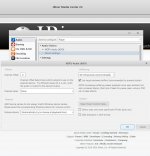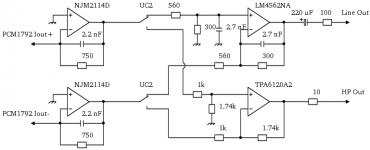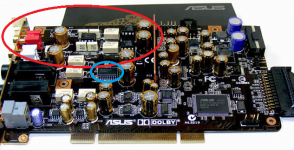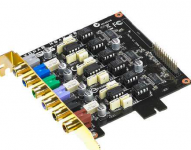Would you consider a new DAC 🙂
Pro audio DACs have the levels you need and aren't priced like audiophile DACs.
My Motu Ultralite MKIV has 10 channels of ESS DAC balanced outputs at +20DBu or 21.9 V pk to pk for only $595 US. One a per channel basis, that is less than some of the buffer boards just discussed. Plus it has great MIC preamps and ADC for measurements.
M1 DAC is only 24 bits? That could account for differences also. Gain staging in front of it will be more critical than for a 32 bit DAC. Its hard to run out of digital headroom with a 32 bit DAC but 256 times easier with a 24-bit. Add digital volume control into the mix and maybe you will see issues.
Music Fidelity is up to M6 - now that sounds state of the art! But you wouldn't want to buy it and then have the same issues interfacing with your amps. (I wonder why they don't mention the price on line.)
Upsampling has two major benefits: first it allows use of a lower slope anti-aliasing filter which means less phase shift in the pass band (which really doesn't matter if you are using FIR to flatten phase anyway). Second, it spreads the white quantization noise over the entire band up to the Nyquist rate so more of it is removed by the anti-aliasing filter and you end up with a higher SNR.
I doubt these upsampling benefits would be audible in a DAC comparison. 16 bits vs 32 bits I'd expect to be audible. Guessing that 24 bits vs 32 bits might expose sub-optimal gain staging ....
Pro audio DACs have the levels you need and aren't priced like audiophile DACs.
My Motu Ultralite MKIV has 10 channels of ESS DAC balanced outputs at +20DBu or 21.9 V pk to pk for only $595 US. One a per channel basis, that is less than some of the buffer boards just discussed. Plus it has great MIC preamps and ADC for measurements.
M1 DAC is only 24 bits? That could account for differences also. Gain staging in front of it will be more critical than for a 32 bit DAC. Its hard to run out of digital headroom with a 32 bit DAC but 256 times easier with a 24-bit. Add digital volume control into the mix and maybe you will see issues.
Music Fidelity is up to M6 - now that sounds state of the art! But you wouldn't want to buy it and then have the same issues interfacing with your amps. (I wonder why they don't mention the price on line.)
Upsampling has two major benefits: first it allows use of a lower slope anti-aliasing filter which means less phase shift in the pass band (which really doesn't matter if you are using FIR to flatten phase anyway). Second, it spreads the white quantization noise over the entire band up to the Nyquist rate so more of it is removed by the anti-aliasing filter and you end up with a higher SNR.
I doubt these upsampling benefits would be audible in a DAC comparison. 16 bits vs 32 bits I'd expect to be audible. Guessing that 24 bits vs 32 bits might expose sub-optimal gain staging ....
That sure has been on my mind as well. BYRTT also directed me towards that route and I've always thought of getting a 32 bit DAC as an upgrade. It leaves me with a few questions as how to connect it to the PC.
Long ago I was using an USB connection on the M1 DAC, it proved to be noisy in that configuration making me switch to optical for it's excellent isolation.
But it isn't out of the equation, going that route might be a valid upgrade as well. Which is the reason no Universal Buffers were ordered until I have examined alternatives.
Thanks for thinking with me 🙂. I did look at some pro alternatives quite a while ago and should not rule it out.
Is this the back side?
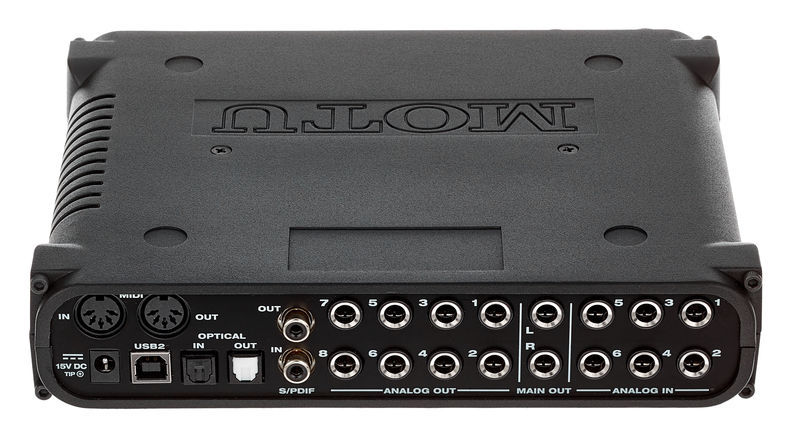
Balanced Jack out? Does it present itself as an 8 (eh 10) channel sound card inside the PC? (forgot the L and R in my count)
Long ago I was using an USB connection on the M1 DAC, it proved to be noisy in that configuration making me switch to optical for it's excellent isolation.
But it isn't out of the equation, going that route might be a valid upgrade as well. Which is the reason no Universal Buffers were ordered until I have examined alternatives.
Thanks for thinking with me 🙂. I did look at some pro alternatives quite a while ago and should not rule it out.
Is this the back side?
Balanced Jack out? Does it present itself as an 8 (eh 10) channel sound card inside the PC? (forgot the L and R in my count)
Attachments
Last edited:
That sure has been on my mind as well. BYRTT also directed me towards that route and I've always thought of getting a 32 bit DAC as an upgrade. It leaves me with a few questions as how to connect it to the PC.
Long ago I was using an USB connection on the M1 DAC, it proved to be noisy in that configuration making me switch to optical for it's excellent isolation.
But it isn't out of the equation, going that route might be a valid upgrade as well. Which is the reason no Universal Buffers were ordered until I have examined alternatives.
Thanks for thinking with me 🙂. I did look at some pro alternatives quite a while ago and should not rule it out.
Is this the back side?
Balanced Jack out? Does it present itself as an 8 (eh 10) channel sound card inside the PC? (forgot the L and R in my count)
If your not familiar with balanced jacks, they can be either xlr or 1/4" TRS (tip-ring-shield). TRS are often used in devices like the MOTO where jack mounting space is at a premium.
FWIW, one of my most pleasant audio encounters has been how much easier, less expensive, and I dare say better, .... balanced +4dBu pro gear has been than my previous consumer equipment.
A 1.23V = +4dBu live level output, with typically 17dB headroom or greater, is pretty much a given in pro-gear world. Amp input sensitivities settings are built around that spec.
None of the wildly varying consumer I/O and amp specs built around -10dBV.
And imho, a 50ft $20 balanced cable is superior signal wise, to a 3 ft pure silver $$$ RCA cable.
Honestly, after several years away from consumer gear, I now equate using single ended equipment and RCA interconnects to having a mild cold or headache....
Love those balanced TRS jacks, patch cords for loopback, and all the TRS to XLR/RCA/... adapters I can get for them for just a few bucks each.
Motu presents to the OS as 1-24 inputs and outputs; their largest device goes that high. They have a console that allows routing any usb input stream to any output; same for input streams.
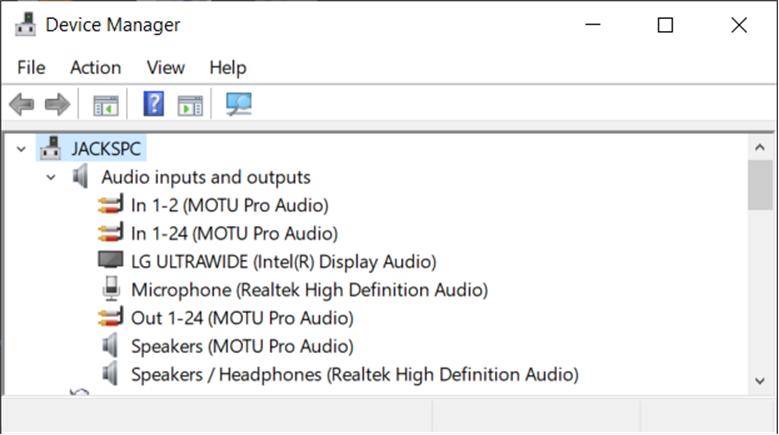
In JRiver you select Motu as the output device and then can specify a channel offset with advice to choose different values until the routing works. I got it right on the first try. Beyond that, for multiple channels you have to get into a configuration file, where I have yet to venture.
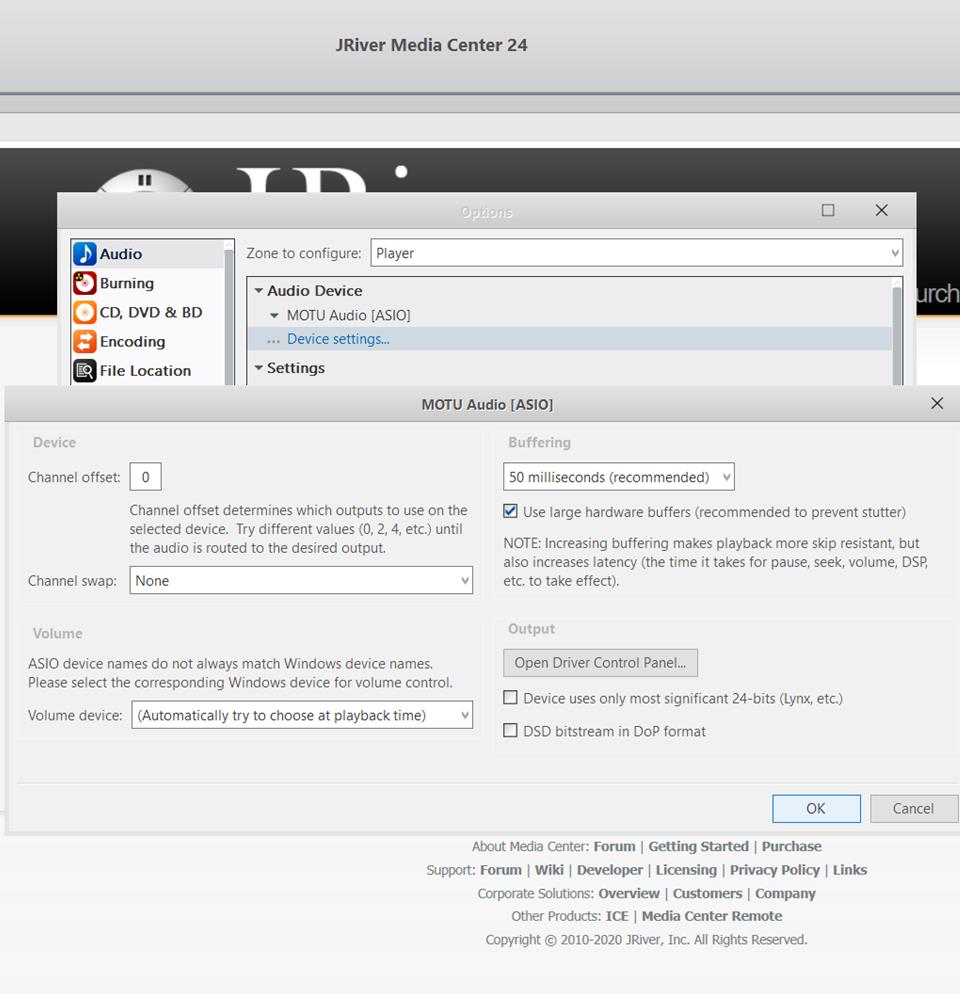
Motu presents to the OS as 1-24 inputs and outputs; their largest device goes that high. They have a console that allows routing any usb input stream to any output; same for input streams.
In JRiver you select Motu as the output device and then can specify a channel offset with advice to choose different values until the routing works. I got it right on the first try. Beyond that, for multiple channels you have to get into a configuration file, where I have yet to venture.
Attachments
I should revise this as the second part is not right.According to the datasheet the input sensitivity for a 4 Ohm load is 2.35V for 500W output. So 2V SE would get you very close.
According to the datasheet the Hypex needs 2.35V balanced input to reach maximum power at 4 Ohms load. Given that the Hypex is not a fully differential amplifer (but has a differential front end that will combine the two halves of the signal) the input to the amp section will be half that around 1.2V which is very close to the +4dBu level, so only about 1.2V of single ended voltage is needed for full power.
If you had access to the output terminals of the amp that could be verified but it needs a bit of test setup and is best done with a purely resistive dummy load.
Given that your main amplifier is single ended to me it does not make sense to covert single ended to balanced and back again if noise is not an issue.
All of the 9018, 9016 and 9032 DAC's that I have sound very similar to each other with the cheap little Topping D50 edging them all out. I tend to prefer the ESS signature over AKM in anything I have built but the differences are quite small and I could happily listen to all of them. Before you spend big EUROS beg borrow or buy a D50 for a listen, has USB coaxial and Optical inputs, I cannot hear a difference between USB straight from the computer or coaxial via the Focusrite 18i20.
Most of the Pro interfaces do not sound quite as good as the best stereo DAC's, using a pro interface for the ambience and sub channels and daisy chaining a stereo DAC digitally from it works really well. The pro DAC is the timing master so everything stays in sync but you get to choose your main 2 channel DAC separately.
On the flip side the OKTO research 8 channel DAC measures extremely well but it is not cheap.
What's so cute to me is that every one of us has a different story to be told. I really like the idea to go pro and really have an abundance of power available....
Yet, I do know what i've got, and it isn't too far off of a really good place. i've had fun, I've had joy, and really... i do believe that what I got here is just inches away from a really good thing.
I should not be posting this on this early morning here in the Netherlands. I've just visited a really good Pink Floyd cover band and had way to many beers to be coherent.
Still I think there might be a few brain cells that might work ok, who knows. What would I have to lose, getting myself 3 of those Universal buffers with appropriate power supplies. I agree with Fluid here. The SE inputs isn't what's holding me back right now. I can't quite say I agree with the Hypex situation, but time would tell if going balanced in on them makes any difference.
The Hypex surely isn't like the Goldmund, that's for sure. That Goldmund is a monster in disguise. 24 mosfets, 12 on each side making up the total power with batteries of capacitors backing it up does seem to do more than alright.
That is an understatement. 😉
In comparison, 500 watt is all you're going to get out of that Hypex power, no more, no less. While in reality it's more like a 125 watt continuous power amplifier if I do read its specs right. Still plenty for what I need. As that 500 watt is what it can bring for peak power, but it isn't anything like that powerhouse that is captured inside the Goldmund philosophy. Does it look like I'm sold to that particular concept? I really am... even if that 350 watt into 8 ohm seems to vanish compared to the hypex numbers on first sight, I do think that's not telling the true story here.
Please excuse me, maybe I'm more honest due to being intoxicated, maybe I'm just being a pain in the you know what. But from what I've heard, that Goldmund can deliver, all it really needs is some undisturbed clean input signal (without limits) and away it goes. So all I really need is that clean input signal. Something that goes past a fixed 2 volts RMS barrier like I have now.
I'm not worried about the DAC being 24 bit at this moment, as I don't lose the ability to play a true 16 bit, 44100 CD quality, in which most of my treasures are captured. I might venture into different things in the future, but right now, just getting the needed headroom, just as I planned to get seems like a pretty safe bet to me.
Home theatre might be played about 5 dB lower on average compared to Stereo, still not losing enough bits to lose sleep over. Infact, HT is probably the best thing I've got right now, before fixing all of the gain problems I really need to fix.
Any more pointers about the Hypex input? I still believe giving it a 2 volts RMS balanced signal would provide more output than 2 volts RMS Single Ended input. I do realise I don't quite know quite enough to verify this. I've got one opinion saying balanced 2 volts input will raise output by +6 dB. And another saying even 1.2 volt SE would be enough (which in the current state I'm in I truly doubt). Personally I do think it needs the balanced 2 volts RMS input to reach it's true potential. But what do I know.... 😀
Any more giving this a go? Can't wait to read about it in the morning, to soften the headache that will surely follow this input of a couple to many beers. 🙂
If that Octo DAC would have more gain options I'd take it at that price level. The measurements look like nothing I've seen before.
That Stereo DAC of theirs is even more crazy. Using 8 pairs to get 2 channels of greatness. Can't wait until someone tests that device.
Yet, I do know what i've got, and it isn't too far off of a really good place. i've had fun, I've had joy, and really... i do believe that what I got here is just inches away from a really good thing.
I should not be posting this on this early morning here in the Netherlands. I've just visited a really good Pink Floyd cover band and had way to many beers to be coherent.
Still I think there might be a few brain cells that might work ok, who knows. What would I have to lose, getting myself 3 of those Universal buffers with appropriate power supplies. I agree with Fluid here. The SE inputs isn't what's holding me back right now. I can't quite say I agree with the Hypex situation, but time would tell if going balanced in on them makes any difference.
The Hypex surely isn't like the Goldmund, that's for sure. That Goldmund is a monster in disguise. 24 mosfets, 12 on each side making up the total power with batteries of capacitors backing it up does seem to do more than alright.
That is an understatement. 😉
In comparison, 500 watt is all you're going to get out of that Hypex power, no more, no less. While in reality it's more like a 125 watt continuous power amplifier if I do read its specs right. Still plenty for what I need. As that 500 watt is what it can bring for peak power, but it isn't anything like that powerhouse that is captured inside the Goldmund philosophy. Does it look like I'm sold to that particular concept? I really am... even if that 350 watt into 8 ohm seems to vanish compared to the hypex numbers on first sight, I do think that's not telling the true story here.
Please excuse me, maybe I'm more honest due to being intoxicated, maybe I'm just being a pain in the you know what. But from what I've heard, that Goldmund can deliver, all it really needs is some undisturbed clean input signal (without limits) and away it goes. So all I really need is that clean input signal. Something that goes past a fixed 2 volts RMS barrier like I have now.
I'm not worried about the DAC being 24 bit at this moment, as I don't lose the ability to play a true 16 bit, 44100 CD quality, in which most of my treasures are captured. I might venture into different things in the future, but right now, just getting the needed headroom, just as I planned to get seems like a pretty safe bet to me.
Home theatre might be played about 5 dB lower on average compared to Stereo, still not losing enough bits to lose sleep over. Infact, HT is probably the best thing I've got right now, before fixing all of the gain problems I really need to fix.
Any more pointers about the Hypex input? I still believe giving it a 2 volts RMS balanced signal would provide more output than 2 volts RMS Single Ended input. I do realise I don't quite know quite enough to verify this. I've got one opinion saying balanced 2 volts input will raise output by +6 dB. And another saying even 1.2 volt SE would be enough (which in the current state I'm in I truly doubt). Personally I do think it needs the balanced 2 volts RMS input to reach it's true potential. But what do I know.... 😀
Any more giving this a go? Can't wait to read about it in the morning, to soften the headache that will surely follow this input of a couple to many beers. 🙂
On the flip side the OKTO research 8 channel DAC measures extremely well but it is not cheap.
If that Octo DAC would have more gain options I'd take it at that price level. The measurements look like nothing I've seen before.
That Stereo DAC of theirs is even more crazy. Using 8 pairs to get 2 channels of greatness. Can't wait until someone tests that device.
Last edited:
Aloha Ronald, I hope you are well. I am digging your subs and artwork!
Review and Measurements of Okto DAC8 8Ch DAC & Amp | Audio Science Review (ASR) Forum
I have been a Pro Dac guy myself for a long time. Lynx is my poison for decades, with the Lynx Hilo the latest purchase in 2012 - 6 analog output channels for my 3 way tri-amped system.
There are a lot of multi-channel pro converters on the market today. Another one that is easier on the pocket book: UR824 | Steinberg
I like that it comes with a multi-client ASIO driver (like my Hilo) which opens the door for interesting experiments.
Keep up the fun man!
Cheers!
Mitch
Review and Measurements of Okto DAC8 8Ch DAC & Amp | Audio Science Review (ASR) Forum
I have been a Pro Dac guy myself for a long time. Lynx is my poison for decades, with the Lynx Hilo the latest purchase in 2012 - 6 analog output channels for my 3 way tri-amped system.
There are a lot of multi-channel pro converters on the market today. Another one that is easier on the pocket book: UR824 | Steinberg
I like that it comes with a multi-client ASIO driver (like my Hilo) which opens the door for interesting experiments.
Keep up the fun man!
Cheers!
Mitch
It is power supply and heat limited being an all in one model. The SMPS cannot supply a continuous 500W without overheating but it can provide big peaks over the 500W for short periods, the issue would be that if you got that power the distortion would be high due the way the class D works. Put a massive fan over the power supply and it probably could make 500w continuous, but who wants that.In comparison, 500 watt is all you're going to get out of that Hypex power, no more, no less. While in reality it's more like a 125 watt continuous power amplifier if I do read its specs right.
I would ask Koldy what the input sensitivity of the Goldmund is, most are set below 2V more like 1.4V to make sure they work with a wide variety of sources. More voltage than that sensitivity figure won't help anything.Please excuse me, maybe I'm more honest due to being intoxicated, maybe I'm just being a pain in the you know what. But from what I've heard, that Goldmund can deliver, all it really needs is some undisturbed clean input signal (without limits) and away it goes. So all I really need is that clean input signal. Something that goes past a fixed 2 volts RMS barrier like I have now.
I think when the beers have been processed you might see that the two statements here are not actually different 😉Any more pointers about the Hypex input? I still believe giving it a 2 volts RMS balanced signal would provide more output than 2 volts RMS Single Ended input. I do realise I don't quite know quite enough to verify this. I've got one opinion saying balanced 2 volts input will raise output by +6 dB. And another saying even 1.2 volt SE would be enough (which in the current state I'm in I truly doubt). Personally I do think it needs the balanced 2 volts RMS input to reach it's true potential. But what do I know.... 😀
The balancing normally results in a +6dB voltage gain (over single ended) from the difference between the two signals lowest and highest points.
If your amplifier itself is differential then this voltage can go straight in, Tom's MOD686 is differential, balanced bridged.
Most amps yours included are single ended so a balanced signal has to be converted back down to single ended inside the amp or before. It is this conversion that reduces the voltage back down.
In the case of the Hypex 500W 4 Ohms is produced with 2.35V balanced or ~1.2V single ended from my reading of the datasheet.
This why a single ended to balanced conversion and back again results in no overall change to the voltage except in the transmission stage, where the higher voltage and differential nature allows a cleaner path with less induced noise.
Make sense?
Aloha Ronald, I hope you are well. I am digging your subs and artwork!
Review and Measurements of Okto DAC8 8Ch DAC & Amp | Audio Science Review (ASR) Forum
I have been a Pro Dac guy myself for a long time. Lynx is my poison for decades, with the Lynx Hilo the latest purchase in 2012 - 6 analog output channels for my 3 way tri-amped system.
There are a lot of multi-channel pro converters on the market today. Another one that is easier on the pocket book: UR824 | Steinberg
I like that it comes with a multi-client ASIO driver (like my Hilo) which opens the door for interesting experiments.
Keep up the fun man!
Cheers!
Mitch
Thanks for the input Mitch,
I'll certainly look into it.
It is power supply and heat limited being an all in one model. The SMPS cannot supply a continuous 500W without overheating but it can provide big peaks over the 500W for short periods, the issue would be that if you got that power the distortion would be high due the way the class D works. Put a massive fan over the power supply and it probably could make 500w continuous, but who wants that.
Makes sense. For what it has to do I think it's more that adequate.
I would ask Koldy what the input sensitivity of the Goldmund is, most are set below 2V more like 1.4V to make sure they work with a wide variety of sources. More voltage than that sensitivity figure won't help anything.
The original schematics of this amp do show a 6 dB gain pré amp. Koldby did decide against it for his own personal use. I still believe the headroom does do me some good, enough to follow that path. In other words, the original Goldmund Telos 400 does have a pré-amp section, however it also has a plus or minus 9 db adjustability to get the gainstructure right.
The specs say:
However that does not tell anything about the pré-amp section being part of it or not. All I know is that to match the level to the Pioneer with the volume dial at 3/4 it needed extra gain between 9 to 12 dB. Which seemed strange for a 29 dB gain amplifier to me. The Pioneer having these specs:nput Sensitivity
Nominal level : 1.45 V RMS.
Voltage Gain : 29dB, adjustable by rear panel.
Input impedance : 51 kOhms.
Specifications
Power output: 100 watts per channel into 8Ω (stereo)
Frequency response: 1Hz to 150kHz
Total harmonic distortion: 0.003%
Damping factor: 70
Input sensitivity: 0.2mV (MC), 2.5mV (MM), 150mV (line)
Signal to noise ratio: 77dB (MC), 95dB (MM), 110dB (line)
Output: 150mV (line)
Dimensions: 420 x 435 x 162mm
Weight: 19.5kg
I think when the beers have been processed you might see that the two statements here are not actually different 😉
The balancing normally results in a +6dB voltage gain (over single ended) from the difference between the two signals lowest and highest points.
If your amplifier itself is differential then this voltage can go straight in, Tom's MOD686 is differential, balanced bridged.
Most amps yours included are single ended so a balanced signal has to be converted back down to single ended inside the amp or before. It is this conversion that reduces the voltage back down.
In the case of the Hypex 500W 4 Ohms is produced with 2.35V balanced or ~1.2V single ended from my reading of the datasheet.
This why a single ended to balanced conversion and back again results in no overall change to the voltage except in the transmission stage, where the higher voltage and differential nature allows a cleaner path with less induced noise.
Make sense?
Not quite, maybe it's the beers. All I got out of reading the datasheet is that supplying 2.35 volt RMS SE would end up not being able to reach its full potential. As it would be seen as half of that by the amp, the 1.2 volt figure.
Not anywhere do I expect 1.2 Volt RMS being valid to reach full potential, sorry for that, must be the beers 😀. I do believe 2.35 volt balanced is needed and 2.35 volt SE would end up being the equivalent of a 1.2 volt balanced input. That's my take on it and why I do expect a 6 dB gain of a balanced 2 volt compared to SE 2 volt. How difficult can this be? 😱
(not meaning any harm, I just don't know the right answer here...)
Oh well, I'd better go sleep off the alcohol overdose right now... See you in quite a few hours, hopefully more clearheaded 😉
Last edited:
The bottom line with an amplifier is this figure. This is how much voltage is needed for the amplifier to produce it's rated output. Assuming Koldby built it to that spec. If you want to feed it more input voltage the 29dB voltage gain will need to be reduced. Maybe you need to hear it from someone else to believe it, perhaps Koldby can confirm.The specs say: Nominal Level 1.45V RMS
Maybe I am not explaining this well to you, I will give it one last go. A 2.35V volt balanced signal will be reduced down to ~1.2V when it is converted from differential to single ended. If you put in 1.2V single ended directly you end up with the same voltage to the amplifier. With a balanced receiver the single ended input voltage is not halved as it is already ground referenced not floating. Same as if you connect the positive and ground connections from a balanced output you get half the differential voltage because it is no longer floating.Not quite, maybe it's the beers. All I got out of reading the datasheet is that supplying 2.35 volt RMS SE would end up not being able to reach its full potential. As it would be seen as half of that by the amp, the 1.2 volt figure.
Not anywhere do I expect 1.2 Volt RMS being valid to reach full potential, sorry for that, must be the beers 😀. I do believe 2.35 volt balanced is needed and 2.35 volt SE would end up being the equivalent of a 1.2 volt balanced input. That's my take on it and why I do expect a 6 dB gain of a balanced 2 volt compared to SE 2 volt. How difficult can this be? 😱
(not meaning any harm, I just don't know the right answer here...)
Oh well, I'd better go sleep off the alcohol overdose right now... See you in quite a few hours, hopefully more clearheaded 😉
I can understand that these voltages might seem low to you but it is what a lot of stuff is designed for between 1V and 2V for rated power output.
The bottom line with an amplifier is this figure. This is how much voltage is needed for the amplifier to produce it's rated output. Assuming Koldby built it to that spec. If you want to feed it more input voltage the 29dB voltage gain will need to be reduced. Maybe you need to hear it from someone else to believe it, perhaps Koldby can confirm.
Koldby did explain it. But what I simply do not understand is why did the schematics show a 6dB gain pré-amp circuit (which is present in the real deal, not in my amp as koldby left that part out) while the amp already has 29 dB gain without it. Is this to be able to adjust the gain with plus or minus 3 dB steps, ranging from +9 dB to minus 9 dB? Something the real deal has as well according to its specs.
Maybe I am not explaining this well to you, I will give it one last go. A 2.35V volt balanced signal will be reduced down to ~1.2V when it is converted from differential to single ended. If you put in 1.2V single ended directly you end up with the same voltage to the amplifier. With a balanced receiver the single ended input voltage is not halved as it is already ground referenced not floating. Same as if you connect the positive and ground connections from a balanced output you get half the differential voltage because it is no longer floating.
I can understand that these voltages might seem low to you but it is what a lot of stuff is designed for between 1V and 2V for rated power output.
Yes, it does seem low but your explanation makes sense. If I have a 2 volt SE output and convert it to differential that would make it 4 volt and I'd have to reduce the gain of that output to make it match SE.
Yes, it does seem low but your explanation makes sense. If I have a 2 volt SE output and convert it to differential that would make it 4 volt and I'd have to reduce the gain of that output to make it match SE.
Reading what you wrote for a second time, this does not seem valid. As the balanced input will half again at the amp. This is what I wanted to know.
Well I think you should go balanced and then adjust the gain somewhere to be gain-neutral. That is probably just some resistor changes when you build the line driver or receiver boards. Dynamic headroom is what you are seeking.
Those two DACs posted by fluid are impressinve, perhaps incredible, especially the Opto. In other words, I'm not sure I believe them, but I don't need to. To me, those measurements show that for a well implemented 32-bit DAC, the measurable imperfections are all well down in the mud, well below the driver imperfections which will certainly mask them. The same may well be true for well done 24 bit DAC, given the SNRs we live with in typical amps.
I have the utmost admiration for engineers that can produce such low levels of noise aand distortion as those DACs - sensitive analog circuits performing in or near a digital environment. I thought it interesting that the D50 performed best on battery power since a switching power supply would otherwise be a primary source of noise. I hope its ability to run off a single 5V supply (USB) doesn't mean its op amps don't have the customary +/-15V supplies.
I can't infer from the discussion whether the amp in question is a hypex or old school class AB. The way an amp gains dynamic headroom is to allow its power supply voltages to charge up on storage capacitors between signal peaks that drain those caps. Both kinds of amps can benefit from that. What you see in the class curves of THD vs power is that there is a steep rise in THD above some power level usually well short of the rated power. But at least for the arrays, I'm sure your amp has much more power than needed, except perhaps at the low end of the spectrum, and that is where its dynamic headroom comes from.
Those two DACs posted by fluid are impressinve, perhaps incredible, especially the Opto. In other words, I'm not sure I believe them, but I don't need to. To me, those measurements show that for a well implemented 32-bit DAC, the measurable imperfections are all well down in the mud, well below the driver imperfections which will certainly mask them. The same may well be true for well done 24 bit DAC, given the SNRs we live with in typical amps.
I have the utmost admiration for engineers that can produce such low levels of noise aand distortion as those DACs - sensitive analog circuits performing in or near a digital environment. I thought it interesting that the D50 performed best on battery power since a switching power supply would otherwise be a primary source of noise. I hope its ability to run off a single 5V supply (USB) doesn't mean its op amps don't have the customary +/-15V supplies.
I can't infer from the discussion whether the amp in question is a hypex or old school class AB. The way an amp gains dynamic headroom is to allow its power supply voltages to charge up on storage capacitors between signal peaks that drain those caps. Both kinds of amps can benefit from that. What you see in the class curves of THD vs power is that there is a steep rise in THD above some power level usually well short of the rated power. But at least for the arrays, I'm sure your amp has much more power than needed, except perhaps at the low end of the spectrum, and that is where its dynamic headroom comes from.
Given that your main amplifier is single ended to me it does not make sense to covert single ended to balanced and back again if noise is not an issue.
Hi fluid:
What is your opinion as to dynamic headroom and how does that figure into the discussion?
It seems to me that we have to stage gains so the output of the ESS DAC chip doesn't approach saturation on peaks. It has a single 3.7 volt supply and a charge pump for the negative rail. Let's say 3V is a safe peak and we have a 10 db crest factor. That puts the nominal RMS level down at .3V. What does that say about the gain that is needed? Its an unknown system level without having circuit details. The DAC chip feeds an op amp output stage that may have gain and hopefully has +/-15 volt rails. I'm sure this is the case in pro DACs that feed differential outputs at 20 DBu max. How else could they meet that spec?
If in the Xonar, the output stage doesn't have those tall rails (it might have +/- 5V supplies) it doesn't have the dynamic headroom needed. That was the hypothesis. If only we could poke around with a scope probe on the output we could be sure.
If there is lack of headroom there, solution would be to reduce the gain prior to the DAC and restore it after the DAC with a gain stage. Converting to double ended would give 6 db more gain which needs to be compensated earlier. Just adding gain post DAC without going balanced would also do it e.g. the missing preamp.
I guess I've ended up agreeing with your comment. I'm obviously biased in favor of balanced. Its kept me out of trouble more than once and I have an ART Clean Box in daily use between the RCA sub output from an AV RCVR and a pro amp.
Still confused about the net gain going through SE to balanced and back, but know it could be set anywhere needed by resistor value ratios in the balanced line receiver🙂
Take this as clarification to my previous post and my fuzzy thinking without excuse of alcohol, although I did have a taste of bourbon last night. Going balanced is an alternative but gain neutrality should be done via gain staging to keep DAC away from saturation on peaks.
Last edited:
Hi guys it looks talk goes Xonar ST is ESS based wich is not the case, its PCM1792 for mains and PCM1796 on a daughterboard, did post that analog out section pages back but lets take it again so talk can be based what is there 🙂
Difference in schematic for PCI card verse daughterbard is UC2 relay and TPA6120 headphone out is only there on mains PCB and then the difference that one time PCM1792 is used for mains and 3 times PCM1796 on daughterboard.
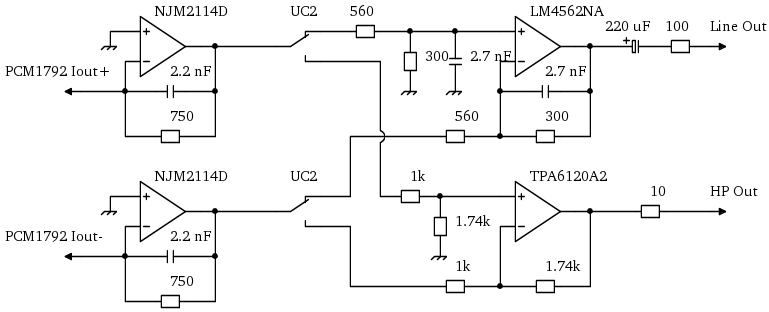
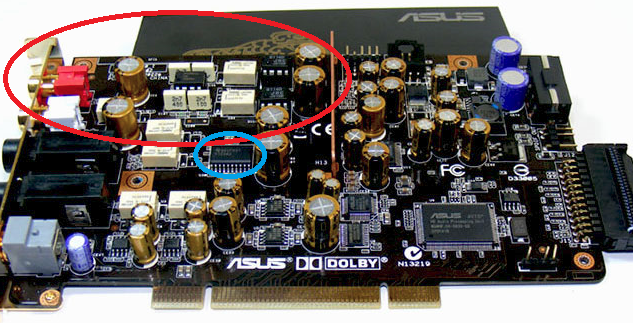
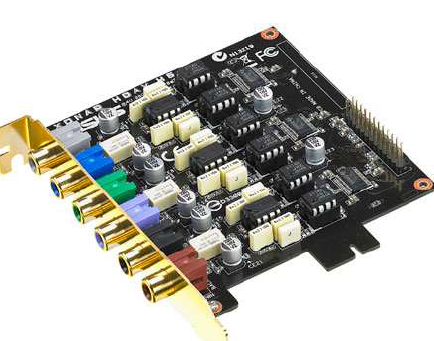
Difference in schematic for PCI card verse daughterbard is UC2 relay and TPA6120 headphone out is only there on mains PCB and then the difference that one time PCM1792 is used for mains and 3 times PCM1796 on daughterboard.
Attachments
Last edited:
No never found that scematic or reverse enginered PCB to tell myself, but can tell card wont work withhout the PSU AUX connector you see on main PCB at upper right side, and if not connected then cards driver software will flash up a dialog tell you need to power down and get that AUX connector done to get soundcard to work, in there is 12 volts available on AUX connector think there's a chance opamps have more than 5 volts, but wait a minutte in daughterboard is kind of flying : ) in my own system i can measure voltage on daughterboards opams within an hour or so and report.
Last edited:
Regarding amplifier input you only need to know 1 parameter, amp gain. From there you can calculate the required input voltage for required output wattage.
Use maximum wattage required, calculate voltage then use the gain factor of amp to divide that voltage. This will give you the input voltage required to drive the amp to that wattage. Assuming the amp can supply this wattage.
P = (V*V)/R to get amplifier voltage, V. Gain = 20*(log)(V/Vo) = amplifer gain. Calculate Vo. I'd get a dac that can go slightly higher than Vo just to be safe, sometimes when DAC reaches its maximum Vo things get dodgy, depends on the DAC.
Use maximum wattage required, calculate voltage then use the gain factor of amp to divide that voltage. This will give you the input voltage required to drive the amp to that wattage. Assuming the amp can supply this wattage.
P = (V*V)/R to get amplifier voltage, V. Gain = 20*(log)(V/Vo) = amplifer gain. Calculate Vo. I'd get a dac that can go slightly higher than Vo just to be safe, sometimes when DAC reaches its maximum Vo things get dodgy, depends on the DAC.
No never found that scematic or reverse enginered PCB to tell myself, but can tell card wont work withhout the PSU AUX connector you see on main PCB at upper right side, and if not connected then cards driver software will flash up a dialog tell you need to power down and get that AUX connector done to get soundcard to work, in there is 12 volts available on AUX connector think there's a chance opamps have more than 5 volts, but wait a minutte in daughterboard is kind of flying : ) in my own system i can measure voltage on daughterboards opams within an hour or so and report.
I guess I looked at the wrong xonar board specs yesterday.
the PCM1792 DACs are impressive. "only" 24 bits but really high SNR
they get around voltage swing limitations by having current outputs and then require op amps to convert current to voltage. In the data sheets, those output op amps have +/- 15V supplies.
PSU AUX should have those voltages. I would guess they would need some filtering before use on hifi analog. That means I'm likely going to need a new hypothesis for Ronald but disproving one is a measure of progress.
I guess I looked at the wrong xonar board specs yesterday.
the PCM1792 DACs are impressive. "only" 24 bits but really high SNR
they get around voltage swing limitations by having current outputs and then require op amps to convert current to voltage. In the data sheets, those output op amps have +/- 15V supplies.
PSU AUX should have those voltages. I would guess they would need some filtering before use on hifi analog. That means I'm likely going to need a new hypothesis for Ronald but disproving one is a measure of progress.
Agree analyze PCM1792/1796 is good stuff even they not new tech anymore, be it curent to voltage converter or output buffer then a mighty 26,2 volts 🙂 was measured on all opamps on daughterboard, guess there is some DC/DC converter and heavy filtering going on in the area on PCB where PSU AUX connector arrive.
- Home
- Loudspeakers
- Full Range
- The making of: The Two Towers (a 25 driver Full Range line array)


